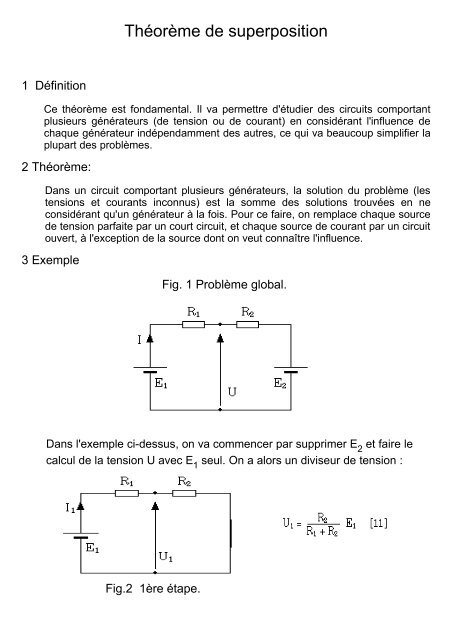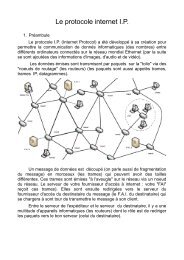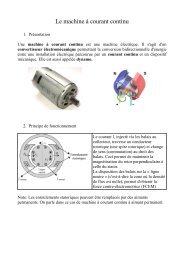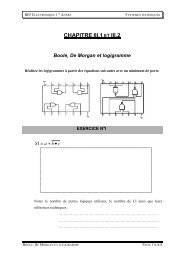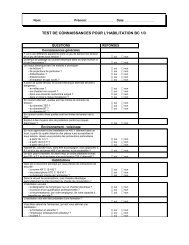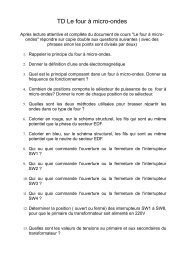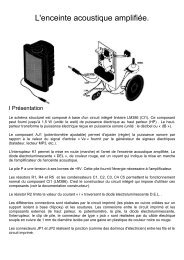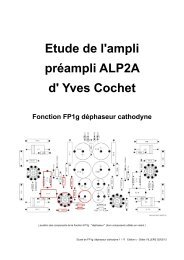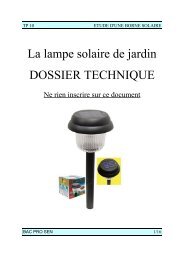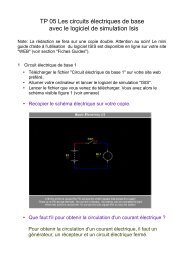Théorème de superposition - didier villers on line
Théorème de superposition - didier villers on line
Théorème de superposition - didier villers on line
You also want an ePaper? Increase the reach of your titles
YUMPU automatically turns print PDFs into web optimized ePapers that Google loves.
Théorème <str<strong>on</strong>g>de</str<strong>on</strong>g> <str<strong>on</strong>g>superpositi<strong>on</strong></str<strong>on</strong>g>1 Définiti<strong>on</strong>Ce théorème est f<strong>on</strong>damental. Il va permettre d'étudier <str<strong>on</strong>g>de</str<strong>on</strong>g>s circuits comportantplusieurs générateurs (<str<strong>on</strong>g>de</str<strong>on</strong>g> tensi<strong>on</strong> ou <str<strong>on</strong>g>de</str<strong>on</strong>g> courant) en c<strong>on</strong>sidérant l'influence <str<strong>on</strong>g>de</str<strong>on</strong>g>chaque générateur indépendamment <str<strong>on</strong>g>de</str<strong>on</strong>g>s autres, ce qui va beaucoup simplifier laplupart <str<strong>on</strong>g>de</str<strong>on</strong>g>s problèmes.2 Théorème:Dans un circuit comportant plusieurs générateurs, la soluti<strong>on</strong> du problème (lestensi<strong>on</strong>s et courants inc<strong>on</strong>nus) est la somme <str<strong>on</strong>g>de</str<strong>on</strong>g>s soluti<strong>on</strong>s trouvées en nec<strong>on</strong>sidérant qu'un générateur à la fois. Pour ce faire, <strong>on</strong> remplace chaque source<str<strong>on</strong>g>de</str<strong>on</strong>g> tensi<strong>on</strong> parfaite par un court circuit, et chaque source <str<strong>on</strong>g>de</str<strong>on</strong>g> courant par un circuitouvert, à l'excepti<strong>on</strong> <str<strong>on</strong>g>de</str<strong>on</strong>g> la source d<strong>on</strong>t <strong>on</strong> veut c<strong>on</strong>naître l'influence.3 ExempleFig. 1 Problème global.Dans l'exemple ci-<str<strong>on</strong>g>de</str<strong>on</strong>g>ssus, <strong>on</strong> va commencer par supprimer E 2et faire lecalcul <str<strong>on</strong>g>de</str<strong>on</strong>g> la tensi<strong>on</strong> U avec E 1seul. On a alors un diviseur <str<strong>on</strong>g>de</str<strong>on</strong>g> tensi<strong>on</strong> :Fig.2 1ère étape.
Pour avoir la c<strong>on</strong>tributi<strong>on</strong> <str<strong>on</strong>g>de</str<strong>on</strong>g> E 2, <strong>on</strong> fait ensuite la même chose ensupprimant E 1:Fig. 3. 2ème étape.La soluti<strong>on</strong> totale U est égale à la somme <str<strong>on</strong>g>de</str<strong>on</strong>g>s <str<strong>on</strong>g>de</str<strong>on</strong>g>ux soluti<strong>on</strong>sprécé<str<strong>on</strong>g>de</str<strong>on</strong>g>mment trouvées :On voit bien ici l'intérêt <str<strong>on</strong>g>de</str<strong>on</strong>g> ce théorème : <strong>on</strong> applique <str<strong>on</strong>g>de</str<strong>on</strong>g>ux fois la formuledu p<strong>on</strong>t diviseur <str<strong>on</strong>g>de</str<strong>on</strong>g> tensi<strong>on</strong> et le tour est joué ! Il n'y a pas eu besoin <str<strong>on</strong>g>de</str<strong>on</strong>g>recourir aux équati<strong>on</strong>s lour<str<strong>on</strong>g>de</str<strong>on</strong>g>s <str<strong>on</strong>g>de</str<strong>on</strong>g> la loi <str<strong>on</strong>g>de</str<strong>on</strong>g>s mailles.Tout comme pour le théorème <str<strong>on</strong>g>de</str<strong>on</strong>g> thévenin, <strong>on</strong> utilisera ce théorème avecune extrême pru<str<strong>on</strong>g>de</str<strong>on</strong>g>nce quand <strong>on</strong> aura affaire à <str<strong>on</strong>g>de</str<strong>on</strong>g>s sources commandées( c'est à dire que les sources <str<strong>on</strong>g>de</str<strong>on</strong>g> tensi<strong>on</strong> s<strong>on</strong>t indépendantes l'une <str<strong>on</strong>g>de</str<strong>on</strong>g>l'autre).


